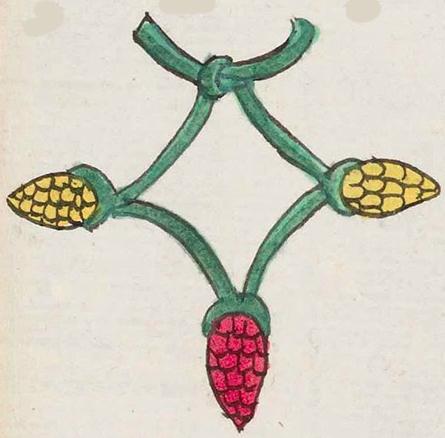Cincozcac (Mdz34r)
This compound glyph for the place name Cincozcac features three maize cobs (cintli), two yellow and one red, strung on a green (possibly leather?) thong that ties at the top, making them into a necklace (cozcatl). The locative suffix (-c) is not shown visually.
Stephanie Wood
The word cintli implied dried maize cobs, the kind that can be degrained, with kernels that could be ground. It may be significant that the red cob is the one that would hang over the chest, perhaps symbolizing a heart? A contemporary Chicana artist, Yolanda Guerra, has merged heart imagery with corn kernels in a print from 2014.
Berdan and Anawalt (1992, 1:`85) point out that the glyph for Cincozcac in the Matrícula de Tributos (7v) has all three cobs colored red.
Stephanie Wood
cincozcac. puo
Cincozcac, pueblo
Stephanie Wood
c. 1541, or by 1553 at the latest
Stephanie Wood
The maize cobs have become part of the necklace. They are merged into one thing, athough they represent two different nouns.
maize, corn, maíz, mazorcas, elotes, collares, necklaces, centli, nombres de lugares

cin(tli), dried ears of maize, https://nahuatl.wired-humanities.org/content/cintli
cozca(tl), necklace, https://nahuatl.wired-humanities.org/content/cozcatl-0
-c (locative suffix), on or in, https://nahuatl.wired-humanities.org/content/c
"Maize Necklace Place" [Frances Karttunen, unpublished manuscript, used here with her permission.]
"On the Maize Jewel" (Berdan and Anawalt, 1992, vol. 1, p. 185)
Codex Mendoza, folio 34 recto, https://digital.bodleian.ox.ac.uk/objects/2fea788e-2aa2-4f08-b6d9-648c00..., image 78 of 188.
The Bodleian Libraries, University of Oxford, hold the original manuscript, the MS. Arch. Selden. A. 1. This image is published here under the UK Creative Commons, “Attribution-NonCommercial-ShareAlike 3.0 License” (CC-BY-NC-SA 3.0).







